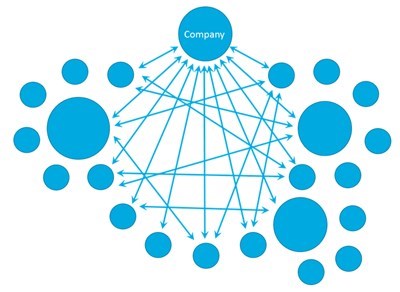Building online B2B communities: Top Tips
18 June 2015
My colleague Alex Skelton and I were recently invited by TechUK to hold a session on how B2B companies can create and grow thriving online communities. After the session, I created the following piece which draws on much of the same content. I thought it worth sharing here...
Firstly, an apology. As someone who, amongst other things, has worked in social media marketing for these past few years I have to take my share of responsibility for the widespread misappropriation of the word ‘community’ and the confusion it has caused. Though I would of course argue that I’ve railed against this misuse for a number of years.
Frankly, most online ‘communities’ in social media quite simply aren’t. A gathering of fans and followers – however large – is only a community if it demonstrates genuine community behaviours. Chief amongst these is regular and direct interaction between its members. Ask yourself this: of those companies and brands that you follow or are a fan of in social media, how many other followers have you interacted with lately? I’d wager it’s not that many. And would you identify yourself as a member of a community in respect to those companies? I very much doubt it.
So the vast majority of companies that believe they are engaged in community management by simply broadcasting content to followers and answering the odd direct question need a bit of a reality check.
Community and business is nothing new
Business has always been about community. Back in the day, of course, it was geographically-defined. The different communities of stakeholders important to your business – customers, employees, suppliers, shareholders and peers – we’re local to you and overlapped. This was often useful in driving ‘good’ corporate behaviour: when all those stakeholders met around the dinner table, in the pub, over the garden fence, on the high street, and in the local working clubs, the reality of how a company behaved mirrored its perception.
As the geographical reach of organisations spread, however, then the ability to directly engage these communities became more difficult, as did the ability of those communities to gather and discuss their relationship with the business in question. In some instances, that allowed businesses to adopt unethical practices towards suppliers or employees, for instance, fairly confident that news of them would not spread and impact reputation amongst customers or shareholders.
Enter the internet
The arrival of online communications and the internet has transformed this picture. The first user forum is widely regarded as being the program created for PLATO in 1973 which allowed users to report bugs online. Since then, the ability for communities to form around businesses online – whether prompted by the organisations themselves or having developed organically – has exploded, bringing benefits and issues in almost equal measure.
The B2B world has been the place where communities have been most well-established, and more than that, the world of technology has lead the charge. This may be due to technologists are pre-disposed towards using technology to connect, or have a natural affinity and passion for answering other people’s questions (seeking and receiving the kudos of peers and the status that brings is a key driver in successful communities), but tech user groups probably remain the purest form of online community, and deliver many lessons that can be employed in online communities of other types. Bug we’ll come back to the top tips in a bit.
Different shapes of community, and what you should aim for
As mentioned in the opening of this piece, most ‘communities’ are anything but. In fact most look like this:

It’s not too difficult to see what’s happened here. The company has established itself (most likely on a social channel such as LinkedIn, Facebook or Twitter) and gathered a group of people around it through various means: outreach, marketing, incentives and promotions. The predominant action in this structure is the broadcast of content from the centre to individuals, with limited and direct one-to-one response. This is on no way a community.
Ultimately, a thriving community would take a shape more akin to this:

In this scenario, the company itself – though still connected to all members of the community as its ‘owner’ – takes a far less central role and, in many cases of successful online communities, isn’t the biggest voice within it. That comes from might be regarded as ‘super-users’. The other clear aspect to this community model is the level of interaction between the members themselves, outside of the company’s own input. Finally, the community growth happens exponentially, with members introducing their own networks and connections.
So if the first model is typical of most company B2B ‘communities’ today, how can you navigate your way to the second? Here are our top tips…
1. Set clear objectives for your business
Any activity needs to align to your organisation’s commercial objectives, particularly those that absorb significant time and resources, and establishing and growing a B2B community definitely qualifies. In simple terms, any activity either needs to clearly align to revenue generation (helping to find new customers and/or selling more to existing ones) or cost reduction. A successful community can help to do both. For example, you might use a community of existing customers to help define the next iteration of existing products or new ones to bring to market (and in doing so have warmed them up to purchase). Or by creating a community within which customers can help solve each other’s’ issues, you can reduce the burden on your own customer service function. Whatever the objective, it needs to be clearly identified and documented.
2. Set clear objectives for the community
While you need to clearly understand the commercial benefits the community will deliver to your business, the members need to equally clearly understand the value they will get from being an active participant. Again, the documentation and communication of this is essential in recruiting members into the community and for defining its content and activities.
3. Getting executive sponsorship, buy-in and participation
Directly related to the first tip, the benefits of applying significant resources to creating, growing and sustaining a successful online community need support at the highest level of your business. But more than a sign-off, the active involvement of executives themselves in community activities and discussions sends a strong message to members about the company’s commitment to its customers (or the specific stakeholder group the community is aimed towards).
4. Fish where the fish are
It’s an old adage in the online world, but the members of your online community are already active somewhere online, so seek them out and engage them where they already are (and if they’re not already active online then forget about bringing them into your own community!) Doing so allows you to better understand their needs and concerns, and to test content that might address them. Over time, it will become clear as to whether establishing your own community is a worthwhile investment.
5. Give your community a (real) personality
If you do decide to take the plunge, your most important investment will be a full-time community manager. People like to engage with other people, not with organisations. They like to feel that they’re speaking to someone knowledgeable, helpful, a peer and mentor; the community manager takes on myriad roles but needs to do so entirely authentically. Ultimately, there may also be offline events for the community and the opportunity to meet in the real world the individual who has become the manifestation of the brand can help deepen relationships which lead to further community growth.
6. Market the community
“Build it, and they will come”. Sadly, that’s not true. You will need to employ some fairly traditional marketing techniques in order to not only recruit members to the community, but to drive their active participation. Email is your friend. Promoting the community, reminders to sign-in, highlighting active discussions and content, giving status to active participants can all be content delivered outside the community through email which will bring more people inside. But be prepared to start small. You already know the first members of your community, because they’re some of the customers that you deal with on the most regular basis. Invite them in personally, ask for their advice and input, give them status, and incentivise them to bring their own networks to the community.
7. Measure
Back to the start: have you achieved your objectives? The only way to ensure on-going funding for the community is to demonstrate that it’s been a success and is delivering a return on investment. You can only do that having set and agreed clear, commercially-aligned objectives. Has the community helped you to sell more? Has it meant an identifiable reduction in costs? Has customer satisfaction increased because of the community? Whatever your objectives a thriving online community can help you meet them.

